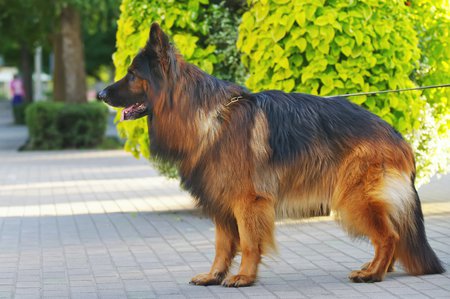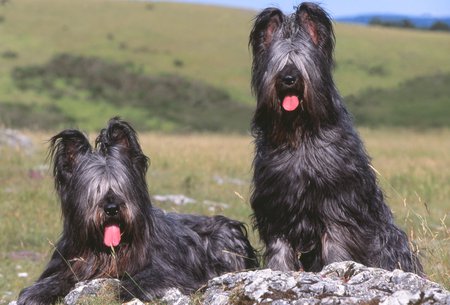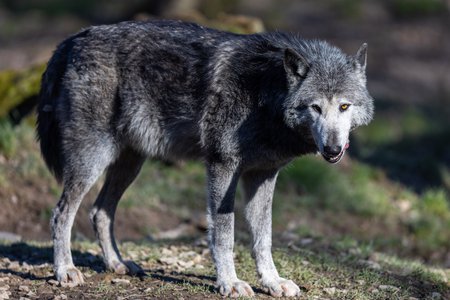Grooming Requirements by DNA
The grooming requirements for your puppy will depend on the genes it inherits.
As many have said, some of our dogs have the "low shedding" gene. This gene doesn't really mean it sheds less, sorry to say. It means that the undercoat has a more difficult time shedding. It is sort of a misnomer to say "low shedding", but that's what is described by DNA.
When the undercoat is retained over time, debris and oils create a foul body odor to build over time. Dogs with this "low shedding" gene benefit from regular baths so that they can keep their coat clean.
At the same time, as stated, a low shedding dog doesn't want to give up its undercoat easily. That means more vigorous brushing is required to get it to release.
I wrote an article listing 3 reasons why it is better to have a "high shedding" dog.
https://direwolfproject.com/.../3-reasons-shedding-dogs.../
There is another gene that regulates hair growth between the pads of the feet, behind the legs and ears. It is called "feathering".
A dog with feathering grows long, human-like hair in these areas that mat easily requiring extra grooming. Also, the extra long hair between the toes and pads of the feet soak up moisture and snow build up causing balls of snow to form.
For these reasons, many people with feathered dogs choose to shave or cut the hair between the pads, and behind the legs and ears.
If you don't want to have extra grooming duties, then make sure your dog does not have feathering.
FYI: Some people call a feathered dog, a long-haired dog, such as the long-haired German Shepherd Dog.

In fact, even Embark Veterinary calls feathering "long hair". However, through our work at the Dire Wolf Project, overall hair length is not simply feathering. I have produced long-haired dogs without feathering. Wolves are a perfect example of this. They have long hair length but do not have feathering. Therefore, I make a distinction between long-hair and feathering. They are two different things.
Lastly, there is a gene that dictates the length of the hairs on the muzzle, forehead, and front of the legs. This is called "furnishings". Breeds like the Irish Wolfhound have this feature. As we have used the Irish Wolfhound in our breed, some of our dogs have furnishings.

Furnishings are inherited by linkage, meaning more than one gene determines how much feathering is present. The more furnishing genes are present in a dog's DNA, the more prominently they will show a bunch of long hairs on the muzzle/forehead and front of the legs.
As you can imagine, a dog with longer hair on the muzzle will retain water and food debris when they drink and eat. If you don't want water spillage on the floor after drinking or having to wipe their mouth after eating moistened dog food, then you don't want a dog with furnishings.
FYI: the opposite of furnishings is called a "clean muzzle".
Now, think about this: Dogs can have one, two, or all of these traits simultaneously.
When two or more of these are combined in the DNA, it compounds the grooming requirements.
Imagine a feathered dog with furnishings that doesn't shed easily. That dog would look like an Old English Sheepdog without the excessive white spotting, or a tawny colored Briard. Probably not the look you are going for.

Luckily for you, we DNA test each and every puppy bred into the Dire Wolf Project and know just what traits we will have in each litter.
The Dire Wolf Project's goal is to breed back the extinct, prehistoric dire wolf. Even though the dire wolf is said to be a different species than the gray wolf, all wild canids living today have "high shedding", "no feathering" and a "clean muzzle". Therefore, it is also our goal to recreate these traits in this combination throughout our entire breed.
If you want the easiest grooming requirements for your next dog, be sure your puppy has "high shedding", "no feathering" and a "clean muzzle" just like the gray wolf and most likely the dire wolf.

Since that is also our aim at the Dire Wolf Project, we actively monitor and breed out the traits that require more grooming. We want as natural a coat as possible.
While all of these traits remain in the breed, both "low shedding" and "feathering" are recessive and are no longer experienced in our puppies.
The only trait that is still a factor for our customers is "furnishings". This trait is easily seen on a puppy even without DNA, so we can tell who has the trait and who doesn't. We also make sure not to breed two dogs who both have furnishings in order to minimize the amount of furnishings seen in any individual puppy.
As much as possible, we select puppies without low shedding, furnishings, or feathering to continue the lines. However, it is important to note that temperament always trumps outward appearance traits. For this reason, sometimes you will see us keep a dog with these traits. This is because the puppy has an overall better temperament than the other puppies in the litter without these traits.
We may have to compromise on our appearance goals if temperament needs dictate it. That is why it has taken the breed since 1988 to even achieve this level of wild canid appearance traits. For the first twenty years of the breed, Lois was completely concerned with health and temperament, disregarding the overall looks of the breed entirely. She had to do this in order to eliminate the long-evolved working dog temperament traits of the foundation and cross dogs she used to establish the breed.
Now, we must always strive to keep this unique calm and gentle companion dog temperament in our giant dog breed. If we lose the amazing companion dog temperament, we have lost an essential ingredient that makes the American Dirus dog so very special.